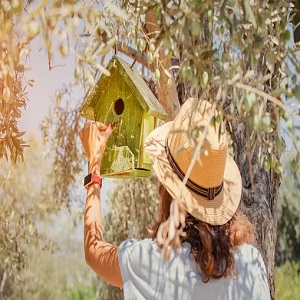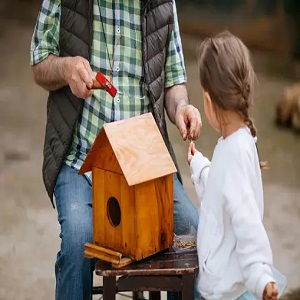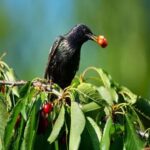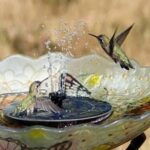Introduction Of Bird Houses
Welcome to the World of Bird Houses, Birds have always been a source of fascination and wonder for people of all ages. Their melodious songs, graceful flights, and vibrant plumage make them an integral part of our natural environment. If you’re reading this guide, chances are you share a deep appreciation for our feathered friends and want to provide them with a safe and inviting place to call home.
One way to do just that is by constructing or selecting the right bird house, but it’s not as simple as picking any wooden box and hanging it in your yard. The choice of wood for your bird house can have a significant impact on its durability, safety, and attractiveness to our avian neighbors. This comprehensive guide is here to help you navigate the intricate world of bird houses, specifically focusing on the best wood options available.

Why Choosing the Right Wood Matters
Bird houses are more than just decorative additions to your backyard; they serve as vital shelters for birds during nesting season. The wood you choose can affect not only the longevity of the bird house but also the well-being of the birds that call it home. Proper wood selection ensures that the bird house remains a safe and cozy haven for generations of birds to come.
In this guide, we’ll explore the various wood options suitable for bird houses, discussing their advantages, characteristics, and how to work with them. Whether you’re a novice birdhouse enthusiast or a seasoned DIYer, this guide will equip you with the knowledge and tools needed to make informed decisions and create bird houses that will stand the test of time.
So, let’s embark on this journey to discover the best wood for bird houses and learn how to create homes that not only enhance your outdoor space but also contribute to the well-being of our avian companions.
Types of Wood for Bird Houses
When it comes to choosing the right wood for your bird house project, several options are available, each with its unique characteristics and suitability. Understanding the pros and cons of different types of wood will help you make an informed decision. Here are some of the most commonly used types of wood for bird houses:

1. Cedar Wood:
- Pros: Cedar is a popular choice for bird houses due to its natural resistance to decay, insects, and rot. It’s lightweight, durable, and has a pleasant aroma. Cedar can withstand outdoor elements well.
- Cons: It tends to be more expensive than some other woods, but its longevity often justifies the cost.
2. Pine Wood:
- Pros: Pine is readily available and budget-friendly. It’s easy to work with and can be painted or stained for added protection and aesthetics. Many bird house enthusiasts prefer pine.
- Cons: Pine is not as naturally resistant to decay and insects as cedar. To improve its longevity, it may need sealing or painting.
3. Redwood:
- Pros: Redwood is a durable and naturally rot-resistant wood. It has an attractive reddish hue and can withstand outdoor conditions for extended periods.
- Cons: Redwood can be expensive, and it’s crucial to ensure it’s sourced sustainably, given concerns about its conservation status.
4. Cypress:
- Pros: Cypress is another rot-resistant wood that holds up well in outdoor environments. It has a unique, attractive grain pattern and is relatively lightweight.
- Cons: Like redwood, cypress can be costly, and it may not be as readily available in all regions.
5. Oak:
- Pros: Oak is a strong, sturdy wood known for its longevity. It can withstand the elements and offers excellent protection to nesting birds.
- Cons: Oak is heavier and harder to work with than some other woods. It may require specialized tools.
6. Other Suitable Woods:
- Pros: Depending on your location and access to specific wood types, you might consider other hardwoods like maple or cherry, as they can also be used for bird houses.
- Cons: These woods may require additional treatment or sealing to enhance their durability.
When choosing the type of wood for your bird house, consider factors such as your budget, the local climate, the species of birds you want to attract, and your willingness to perform maintenance. Keep in mind that regardless of the wood you select, proper preparation and maintenance will play a crucial role in the longevity and success of your bird houses. In the following sections, we’ll delve deeper into the characteristics of these woods and how to work with them effectively.
Characteristics of Bird Houses Woods
The choice of wood for your bird house can significantly impact its durability, safety, and attractiveness to birds. Each type of wood possesses unique characteristics that make it suitable for bird house construction. Understanding these traits will help you make an informed decision about the best wood for your specific needs.

1. Durability:
- Cedar: Cedar is renowned for its durability. It can resist decay, insects, and rot for many years, making it an excellent choice for long-lasting bird houses.
- Pine: Pine is less durable than cedar but still offers good longevity when properly maintained and sealed.
- Redwood and Cypress: These woods are highly durable and naturally resistant to decay and insects, ensuring a longer lifespan for your bird houses.
- Oak: Oak is extremely durable and can withstand harsh weather conditions, making it an excellent choice if longevity is a top priority.
2. Resistance to Weather:
- Cedar, Redwood, and Cypress: These woods excel in outdoor environments, resisting damage from rain, sun, and humidity. They require minimal maintenance to maintain their integrity.
- Pine: Pine may require more frequent maintenance and sealing to withstand the elements effectively.
- Oak: Oak’s robust nature makes it capable of withstanding various weather conditions without significant damage.
3. Insect Resistance:
- Cedar: Cedar’s natural oils act as a deterrent to insects, protecting both the wood and nesting birds from infestations.
- Redwood and Cypress: These woods also have inherent resistance to insects, reducing the likelihood of pest-related issues.
- Pine and Oak: While less naturally insect-resistant, proper maintenance and sealing can help prevent insect-related problems in pine and oak bird houses.
4. Aesthetic Appeal:
- Cedar: Cedar’s reddish-brown color and pleasant aroma make it an attractive choice for those who appreciate its natural beauty.
- Redwood and Cypress: These woods feature a rich, appealing grain pattern and color, enhancing the visual appeal of your bird house.
- Pine: Pine is a versatile wood that can be easily painted or stained to match your outdoor decor.
5. Weight and Workability:
- Cedar and Pine: These woods are relatively lightweight and easy to work with, making them ideal for DIY bird house projects.
- Redwood, Cypress, and Oak: These woods are denser and heavier, requiring more effort and specialized tools for cutting and shaping.
Why Do Birds Eat Rocks? Do Birds Need To Eat Rocks? 10 Most Important Facts About Them
Choosing the Right Wood Species
Selecting the appropriate wood species is a critical step when building birdhouses. The choice of wood not only affects the durability and longevity of the birdhouse but also impacts its ability to provide a safe and comfortable environment for nesting birds. Here are some key factors to consider when choosing the right wood species for your birdhouse:

1. Durability: Opt for wood species known for their durability and resistance to decay. Cedar, redwood, and cypress are excellent choices in this regard. These woods contain natural oils and chemicals that make them highly resistant to rot and insect infestations, ensuring your birdhouse lasts for many seasons.
2. Weather Resistance: The wood you choose should withstand the elements. Cedar, in particular, is renowned for its ability to endure harsh weather conditions, making it a top pick for outdoor birdhouses. Redwood and cypress also perform well in wet climates.
3. Bird Safety: Consider the safety of the birds. Some woods, like pine, can be treated with harmful chemicals. Avoid using chemically treated wood, as these substances may pose risks to nesting birds and their chicks. Use untreated or non-toxic materials.
4. Aesthetic Appeal: While functionality is paramount, the appearance of the wood can enhance the overall aesthetics of your birdhouse. Some wood species, like oak, offer a rich, attractive finish that can complement your garden or outdoor space.
Preparing Wood for Bird Houses
Preparing wood for birdhouses is a crucial step in ensuring the longevity and safety of these avian abodes. To create a welcoming and safe environment for your feathered friends, follow these steps in preparing the wood:

1.Sourcing Quality Wood: Begin by selecting the right type of wood. Cedar, pine, redwood, and cypress are popular choices due to their natural resistance to decay and insects. Choose wood that is free from knots, cracks, and other imperfections.
2. Seasoning and Treating: Seasoning involves allowing the wood to air dry for several months or even years. This process reduces moisture content, making the wood more stable and less prone to warping or splitting. Alternatively, you can kiln-dry the wood for a quicker drying process.
3. Avoiding Harmful Chemicals: Ensure that the wood you use is untreated or finished with bird-safe, non-toxic coatings. Avoid pressure-treated wood or any wood treated with chemicals harmful to birds.
4. Surface Preparation: Sand the wood’s surfaces to remove any splinters or rough edges, creating a safe and smooth interior for the birds. This also helps in applying any paint or finishes if desired.
Design Considerations

Design Considerations for birdhouses are crucial to ensuring the safety and comfort of your feathered visitors.
1. Bird House Styles: Choose a design that suits the bird species you want to attract. Different birds have varying preferences for entry hole size, interior space, and overall structure. For example, bluebirds prefer smaller, oval-shaped entry holes, while woodpeckers need a sturdy, vertical design with ample space.
2. Size and Dimensions: Ensure the dimensions of your birdhouse are appropriate for the target species. Smaller houses are better suited for wrens, chickadees, and finches, while larger ones accommodate bluebirds, martins, or owls. The size also affects ventilation, so consider the climate in your area.
3. Ventilation and Drainage: Adequate ventilation is essential to prevent overheating during hot weather. Add ventilation holes or gaps beneath the roof, but make sure they won’t let in rain. Proper drainage is equally important to keep the nest dry.
4. Material Durability: Select a wood species known for its durability and resistance to decay and insects. Cedar and redwood, for instance, are excellent choices due to their natural resistance.
5. Predator Protection: Design your birdhouse with predator guards, such as baffles or extended roof overhangs, to deter squirrels, raccoons, and snakes from reaching the nest.
6. Accessibility for Cleaning: Make sure the birdhouse is easy to open or clean after each nesting season. A hinged roof or a removable front panel can simplify this task.
7. Natural Aesthetics: Consider the aesthetics of the birdhouse to ensure it complements your outdoor space. A well-designed birdhouse can be both functional and decorative.
Building Your Bird House
Constructing a birdhouse is a rewarding DIY project that not only enhances your garden’s aesthetic appeal but also provides a safe haven for feathered friends. Here’s a concise guide on building your birdhouse:

1. Materials and Tools: Gather the necessary materials like your chosen wood, screws, nails, a saw, drill, measuring tape, and safety gear.
2. Design: Select a birdhouse design suitable for your local bird species. Common designs include cavity-style, platform, or gourd birdhouses.
3. Dimensions: Adhere to recommended dimensions, including entrance hole size and interior dimensions, to attract specific bird species.
4. Cutting and Assembling: Cut your wood pieces to size following your chosen design. Assemble the birdhouse using screws or nails, ensuring it’s secure and durable.
5. Ventilation and Drainage: Incorporate ventilation holes and drainage at the bottom to prevent moisture buildup.
6. Roof and Paint: Attach a roof to protect the birdhouse from the elements. Consider using non-toxic paint or stains for aesthetics, but avoid toxic substances.
7. Entrance Hole: Install an appropriately-sized entrance hole and predator guard to protect nesting birds.
8. Mounting: Choose a suitable location, such as a tree, pole, or building, and mount the birdhouse securely. Ensure it’s at the right height and orientation for the intended bird species.
9. Monitoring: Regularly check the birdhouse for occupancy, clean it between seasons, and make necessary repairs.
10. Enjoyment: Observe the delightful bird activity your birdhouse attracts and take pride in contributing to local wildlife conservation.
Bird House Maintenance
Bird house maintenance is crucial for the well-being of the birds that inhabit these structures and for the longevity of the bird houses themselves. Proper maintenance ensures a safe and inviting environment for your feathered friends.
Regular cleaning is a fundamental aspect of maintenance. Bird houses can accumulate debris, waste, and parasites over time, which can harm the birds. Cleaning should be done at the end of each nesting season to remove old nests and any residue. Use a mild detergent and a soft brush to scrub the interior, and rinse it thoroughly.

Inspect the bird house for any damage, such as cracks, loose parts, or rotting wood. Repair any issues promptly to maintain the structural integrity of the house.
Seasonal upkeep is essential, especially in regions with extreme weather conditions. Check for signs of wear and tear, and consider repainting or refinishing the exterior to protect the wood from the elements.
Lastly, proper placement and monitoring are key. Ensure that the bird house remains securely attached and in a location that offers protection from predators and the elements.
Best Bird Baths For Hummingbirds In 2023
Attracting Birds to Your Bird House
Attracting birds to your bird house is a rewarding experience for bird enthusiasts and provides a safe haven for our feathered friends. Here are some key strategies to entice birds to make your bird house their home.
1. Strategic Placement: Select an appropriate location for your bird house. Different bird species have varying preferences, but generally, placing it at least 5-15 feet above the ground, facing away from prevailing winds, and in a quiet, shaded area can be enticing.
2. Proximity to Food and Water: Ensure your bird house is near a reliable source of food, such as bird feeders, and fresh water. Birds are more likely to nest where they can find sustenance easily.
3. Nesting Material: Some birds prefer to customize their nests. Provide materials like twigs, grass, and leaves nearby so they can easily access them for nest-building.
4. Safety and Security: Birds are cautious creatures. Ensure that the surroundings are safe from predators, like cats and raccoons. You can install predator guards to enhance safety.
5. Seasonal Maintenance: Regularly clean and maintain your bird house, removing old nests after the breeding season to prepare for the next occupants.
6. Patience and Observation: Attracting birds can take time. Be patient and observe the bird activity in your area. Sometimes, it may take a few seasons for birds to discover and trust your bird house.
Conclusion
In the world of avian conservation and appreciation, selecting the right wood for birdhouses is a pivotal decision. This comprehensive guide has shed light on the importance of wood choice and its impact on our feathered friends. We’ve explored various wood options, their characteristics, and how to prepare and maintain birdhouses effectively.
Choosing the best wood for birdhouses involves a thoughtful balance of durability, resistance to the elements, and the specific needs of your local bird species. It’s not just about creating a charming garden ornament; it’s about providing safe, inviting homes for birds that enhance your outdoor space and contribute to biodiversity.
Remember, the journey doesn’t end with wood selection. Regular maintenance, careful placement, and understanding your local avian residents are equally vital. By following the guidance in this guide, you’ll not only create birdhouses that endure but also foster a harmonious coexistence between humans and birds, nurturing the beauty of nature right in your backyard. So, take these insights to heart, and may your birdhouses become a haven for feathered friends and a source of joy for generations to come.
FAQs:
Why is the choice of wood so important for birdhouses?
The type of wood used in a birdhouse can impact its durability, safety, and attractiveness to birds. It’s crucial to select the right wood to ensure a successful birdhouse.
Is cedar wood the only suitable option for birdhouses?
While cedar is a popular choice, there are other suitable woods like pine, redwood, and cypress. Each wood has its own advantages, and the choice depends on various factors.
Can I use reclaimed or recycled wood for birdhouses?
Yes, using reclaimed wood is eco-friendly, but it’s essential to ensure that it’s untreated and safe for birds. We provide guidance on this in our guide.
What’s the best way to protect birdhouses from wood decay and pests?
Our guide covers strategies for preventing wood decay and discouraging pests from infiltrating birdhouses, ensuring the longevity of these habitats.
How can I determine which wood is best for attracting specific bird species to my birdhouse?
Understanding the wood preferences of local bird species is essential. Our guide offers insights into matching wood types with the needs of different birds to enhance your birdhouse’s appeal.
![The Best Wood For Bird Houses: A Comprehensive Guide [2023]](https://vetpomedix.com/wp-content/uploads/2023/09/The-Best-Wood-For-Bird-Houses-A-Comprehensive-Guide-2023.jpg)

